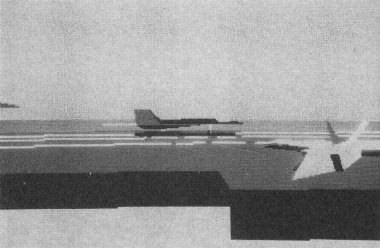The Official F-19 Stealth Fighter Handbook
by Richard Sheffield
The ILS
The Instrument Landing System (ILS) comes in very handy when trying to learn the proper glide slope for a good military landing. I prefer to use the above method for getting lined up and then level out at 500 feet. With the ILS on, I wait for the glideslope bar (the horizontal part of the T) to start to descend. As it crosses the center of the scale, I nose down a little to try and keep in the middle. The ILS will shut off as you get close to the runway. From that point you're on your own, so be ready.
The ILS is most useful when making a carrier landing. Here the glide slope is very important. If you come in too shallow, it's hard to see the deck and judge where to touch down. Of course, if you come in too steep you'll make a real mess on the deck. The same will happen if you try and land from the wrong direction. Remember, when you're coming in from the right direction, the carrier “island” will be on the right-hand side of the deck.

Following the indicated glidepath for a carrier landing is a little frightening at first. It looks like you're coming in awfully steep, but it works well once you get used to it. Since a carrier landing is really a controlled crash, you're allowed to hit the deck much harder than if you were landing on a runway. Just remember to pull the nose up as you land and to add full power in case you miss the cable and have to go around. Doing touch and go landings on a carrier deck can be quite a thrill!
Table of Contents
Previous Section: Takeoffs and Landings
Next Section: Punching Out
